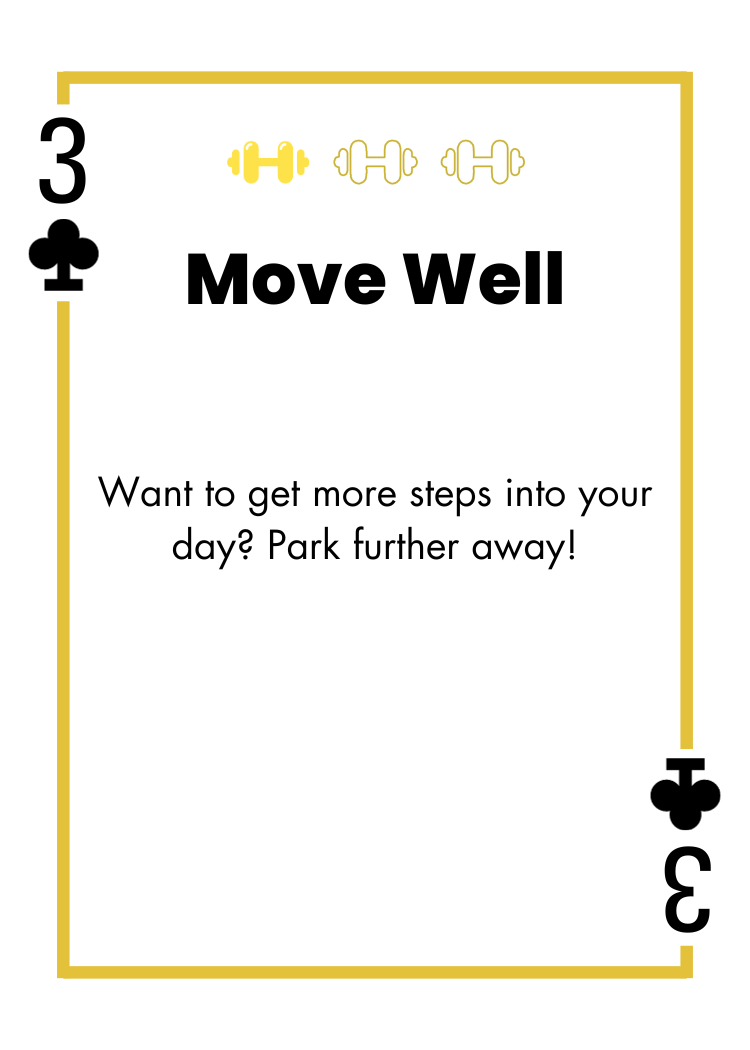3 of Clubs - Park Further

What a great tip! Something as easy as this can boost your steps, every day, every week and every month.
Just by adding an extra 200 more steps everyday totals up 73,000 more steps than you would have done usually.
If you’d like more manageable and achievable tips like that, specific to your lifestyle and goals, sign up to wellness coaching with our experts today. Our physical activity experts can help you integrate movement into your everyday. Exercise doesn’t have to be a chore – let us guide you, 1% at a time.

Very simply, instead of finding the closest parking spot nearest where you need to go, make the decision to park further away to integrate extra steps of walking during your daily routine. Every extra step adds up to better health outcomes!
Adding extra steps during your day will help to reduce sedentary time and is a way to easily increase physical activity.
In November 2018, the Department of Health and Human Services released the second edition of the Physical Activity Guidelines for Americans. The key updates added recommend a) adults should move more and sit less throughout the day, b) some physical activity is better than none and c) adults who sit less and do any amount of moderate-to-vigorous physical activity gain some health benefits (Sprow 2019).
Also, walking works several major muscle groups including the knee extensors (quads), hip extensors (hamstrings and glutes) and muscles of the lower legs (calves and feet). These muscles help pump blood back to the heart, and by exercising them this improves circulation, muscular endurance, and dynamic balance (ACSM).
In a review by Kraus et al. (2019) the authors point out emerging evidence of a linear inverse dose-response relationship of daily steps with important health outcomes. As an individual’s step count increases, the incidence of poor health outcomes decreases. These include all-cause mortality, cardiovascular events, and type 2 diabetes (Kraus et al., 2019).
Steps are a basic unit of locomotion and provide an easily understandable measure of movement. It’s a simple way for individuals to measure their physical activity. Measuring daily step counts can motivate all fitness levels of individuals to increase physical activity levels (Kraus et al., 2019).
https://www.health.harvard.edu/staying-healthy/large-study-finds-the-sweet-spot-for-daily-step-goals
Small changes CAN make a big difference – that’s what The 1% Club is all about.
Kraus, W. E., Janz, K. F., Powell, K. E., Campbell, W. W., Jakicic, J. M., Troiano, R. P., … & 2018 Physical Activity Guidelines Advisory Committee. (2019). Daily step counts for measuring physical activity exposure and its relation to health. Medicine and science in sports and exercise, 51(6), 1206.
Sprow, K. (June 14, 2019). ACSM blog. ACSM_CMS. https://www.acsm.org/blog-detail/acsm-certified-blog/2019/06/14/walking-10000-steps-a-day-physical-activity-guidelines
Starting a walking program – American College of Sports Medicine. (n.d.). https://www.acsm.org/docs/default-source/files-for-resource-library/starting-a-walking-program.pdf?sfvrsn=85e9d2d9_2


 See Other Cards!
See Other Cards!